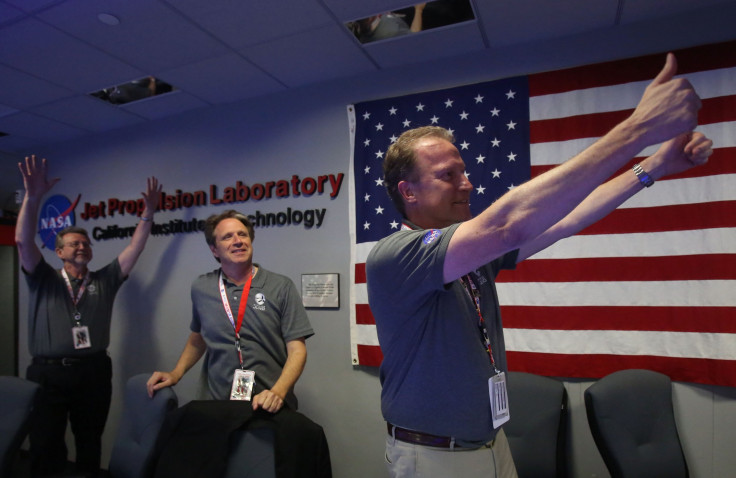NASA’s Juno Mission: Solar-Powered Spacecraft Successfully Enters Jupiter’s Orbit

UPDATE: 1:30 a.m. EDT — NASA scientists have released a spectacular video showing the Jovian moons locked in orbit around its parent planet. The video, made of several still images captured by Juno as it approached Jupiter, shows, for the first time, what Galileo figured out 400 years ago — that the "stars" around Jupiter that weren't moving as expected were actually its moons.
Original story:
NASA’s Juno spacecraft has successfully entered into orbit around Jupiter, completing an extremely risky maneuver during which it had to brave some of the most powerful radiation scientists have ever seen. The solar-powered spacecraft was travelling at a breakneck speed of over 130,000 miles an hour before it fired its engines to slow down enough to be captured by the gas giant’s gravity.
The crucial orbit insertion maneuver began at 11:18 p.m. EDT and was completed at 11:53 p.m. EDT.
Engine burn complete and orbit obtained. I’m ready to unlock all your secrets, #Jupiter. Deal with it.
— NASA's Juno Mission (@NASAJuno) July 5, 2016
All rays on me. My solar panels now face the sun. I’m the farthest solar-powered spacecraft from Earth. #Jupiter
— NASA's Juno Mission (@NASAJuno) July 5, 2016
“You’re the best team ever! We just did the hardest thing Nasa has ever done,” Juno chief scientist Scott Bolton told his colleagues at NASA’s mission control.
Success! Engine burn complete. #Juno is now orbiting #Jupiter, poised to unlock the planet's secrets. https://t.co/YFsOJ9YYb5
— NASA (@NASA) July 5, 2016
Juno was launched in August 2011 and traversed nearly 2 billion miles of space to reach Jupiter. The spacecraft, named after the Roman god Jupiter's wife, will spend the better part of the next 18 months trying to peer through the thick clouds surrounding the massive gas giant. The primary goals of the $1.1 billion mission are to find out whether Jupiter has a solid core, and whether there is water in the planet's atmosphere — something that may not only provide vital clues to how the planet formed and evolved, but also to how the solar system we live in came into existence.
“What Juno's about is looking beneath that surface,” Bolton said before the spacecraft’s arrival at Jupiter. "We've got to go down and look at what's inside, see how it's built, how deep these features go, learn about its real secrets.”
The spacecraft's science instruments will be turned on nearly 50 hours after orbital insertion. However, it will not begin collecting science data until the final burn of the main engine on Oct. 19, when it will shift into a highly-elliptical 14-day orbit from its initial 53.5-day-long orbit.
Once it completes its mission, Juno will dive into Jupiter's atmosphere and burn up — a "deorbit" maneuver that is necessary to ensure that it does not crash into and contaminate the Jovian moons Europa, Ganymede and Callisto.
NASA will hold a press conference at 1 a.m. EDT to provide further details.
© Copyright IBTimes 2024. All rights reserved.






















